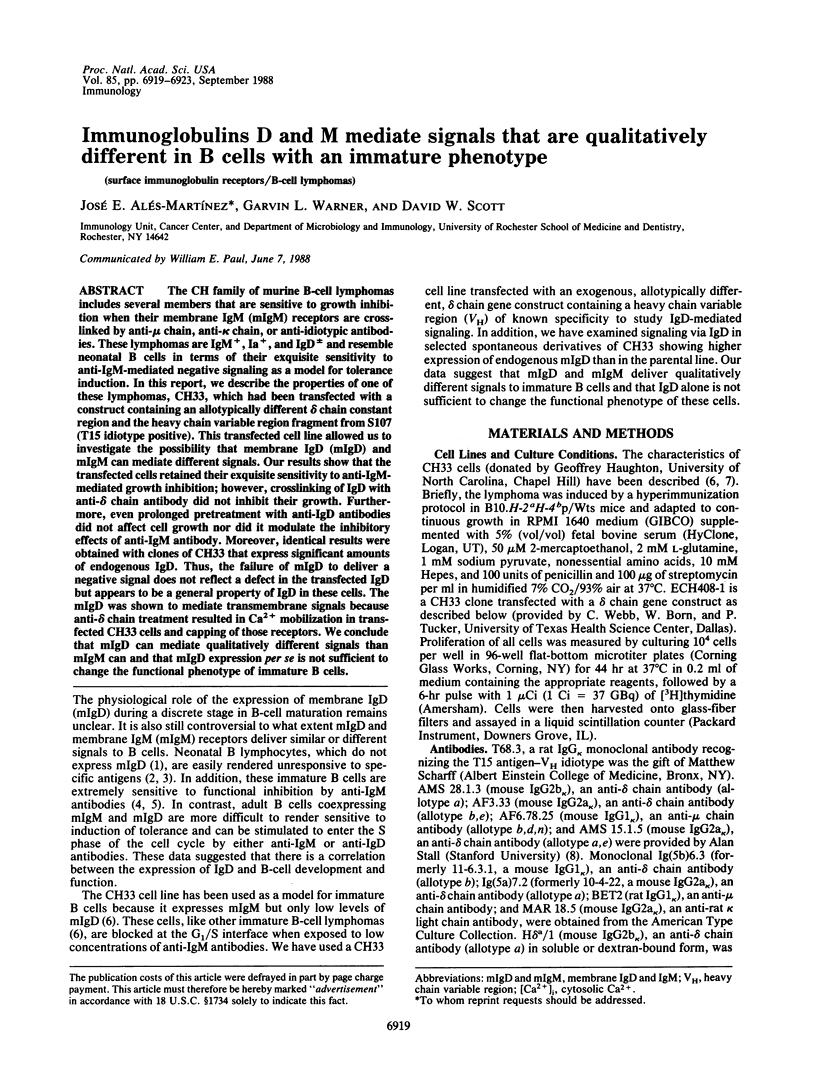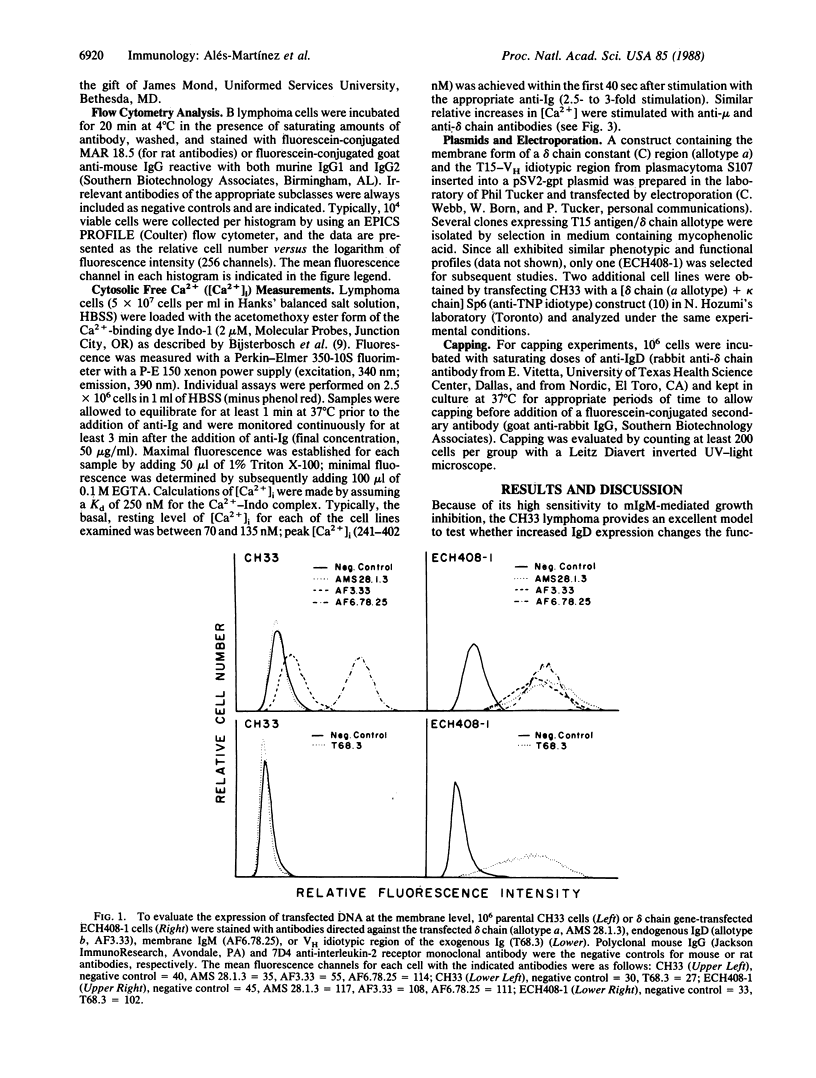Abstract
The CH family of murine B-cell lymphomas includes several members that are sensitive to growth inhibition when their membrane IgM (mIgM) receptors are cross-linked by anti-mu chain, anti-kappa chain, or anti-idiotypic antibodies. These lymphomas are IgM+, Ia+, and IgD +/- and resemble neonatal B cells in terms of their exquisite sensitivity to anti-IgM-mediated negative signaling as a model for tolerance induction. In this report, we describe the properties of one of these lymphomas, CH33, which had been transfected with a construct containing an allotypically different delta chain constant region and the heavy chain variable region fragment from S107 (T15 idiotype positive). This transfected cell line allowed us to investigate the possibility that membrane IgD (mIgD) and mIgM can mediate different signals. Our results show that the transfected cells retained their exquisite sensitivity to anti-IgM-mediated growth inhibition; however, crosslinking of IgD with anti-delta chain antibody did not inhibit their growth. Furthermore, even prolonged pretreatment with anti-IgD antibodies did not affect cell growth nor did it modulate the inhibitory effects of anti-IgM antibody. Moreover, identical results were obtained with clones of CH33 that express significant amounts of endogenous IgD. Thus, the failure of mIgD to deliver a negative signal does not reflect a defect in the transfected IgD but appears to be a general property of IgD in these cells. The mIgD was shown to mediate transmembrane signals because anti-delta chain treatment resulted in Ca2+ mobilization in transfected CH33 cells and capping of those receptors. We conclude that mIgD can mediate qualitatively different signals than mIgM can and that mIgD expression per se is not sufficient to change the functional phenotype of immature B cells.
Full text
PDF




Selected References
These references are in PubMed. This may not be the complete list of references from this article.
- Bijsterbosch M. K., Rigley K. P., Klaus G. G. Cross-linking of surface immunoglobulin on B lymphocytes induces both intracellular Ca2+ release and Ca2+ influx: analysis with indo-1. Biochem Biophys Res Commun. 1986 May 29;137(1):500–506. doi: 10.1016/0006-291x(86)91238-6. [DOI] [PubMed] [Google Scholar]
- Cambier J. C., Ransom J. T. Molecular mechanisms of transmembrane signaling in B lymphocytes. Annu Rev Immunol. 1987;5:175–199. doi: 10.1146/annurev.iy.05.040187.001135. [DOI] [PubMed] [Google Scholar]
- Cambier J. C., Vitetta E. S., Kettman J. R., Wetzel G. M., Uhr J. W. B-cell tolerance. III. Effect of papain-mediated cleavage of cell surface IgD on tolerance susceptibility of murine B cells. J Exp Med. 1977 Jul 1;146(1):107–117. doi: 10.1084/jem.146.1.107. [DOI] [PMC free article] [PubMed] [Google Scholar]
- Goroff D. K., Stall A., Mond J. J., Finkelman F. D. In vitro and in vivo B lymphocyte-activating properties of monoclonal anti-delta antibodies. I. Determinants of B lymphocyte-activating properties. J Immunol. 1986 Apr 1;136(7):2382–2392. [PubMed] [Google Scholar]
- Hardy R. R., Hayakawa K., Haaijman J., Herzenberg L. A. B-cell subpopulations identifiable by two-color fluorescence analysis using a dual-laser FACS. Ann N Y Acad Sci. 1982;399:112–121. doi: 10.1111/j.1749-6632.1982.tb25667.x. [DOI] [PubMed] [Google Scholar]
- Havran W. L., DiGiusto D. L., Cambier J. C. mIgM:mIgD ratios on B cells: mean mIgD expression exceeds mIgM by 10-fold on most splenic B cells. J Immunol. 1984 Apr;132(4):1712–1716. [PubMed] [Google Scholar]
- Isakson P. C., Krolick K. A., Uhr J. W., Vitetta E. S. The effect of anti-immunoglobulin antibodies on the in vitro proliferation and differentiation of normal and neoplastic murineB cells. J Immunol. 1980 Aug;125(2):886–892. [PubMed] [Google Scholar]
- Kearney J. F., Cooper M. D., Klein J., Abney E. R., Parkhouse R. M., Lawton A. R. Ontogeny of Ia and IgD on IgM-bearing B lymphocytes in mice. J Exp Med. 1977 Jul 1;146(1):297–301. doi: 10.1084/jem.146.1.297. [DOI] [PMC free article] [PubMed] [Google Scholar]
- Lawton A. R., 3rd, Cooper M. D. Modification of B lymphocyte differentiation by anti-immunoglobulins. Contemp Top Immunobiol. 1974;3:193–225. doi: 10.1007/978-1-4684-3045-5_8. [DOI] [PubMed] [Google Scholar]
- Metcalf E. S., Schrater A. F., Klinman N. R. Murine models of tolerance induction in developing and mature B cells. Immunol Rev. 1979;43:142–183. doi: 10.1111/j.1600-065x.1979.tb00421.x. [DOI] [PubMed] [Google Scholar]
- Mizuguchi J., Tsang W., Morrison S. L., Beaven M. A., Paul W. E. Membrane IgM, IgD, and IgG act as signal transmission molecules in a series of B lymphomas. J Immunol. 1986 Oct 1;137(7):2162–2167. [PubMed] [Google Scholar]
- Monroe J. G. Up-regulation of c-fos expression is a component of the mIg signal transduction mechanism but is not indicative of competence for proliferation. J Immunol. 1988 Mar 1;140(5):1454–1460. [PubMed] [Google Scholar]
- Nossal G. J., Pike B. L., Teale J. M., Layton J. E., Kay T. W., Battye F. L. Cell fractionation methods and the target cells for clonal abortion of B lymphocytes. Immunol Rev. 1979;43:184–216. doi: 10.1111/j.1600-065x.1979.tb00422.x. [DOI] [PubMed] [Google Scholar]
- Page D. M., DeFranco A. L. Role of phosphoinositide-derived second messengers in mediating anti-IgM-induced growth arrest of WEHI-231 B lymphoma cells. J Immunol. 1988 Jun 1;140(11):3717–3726. [PubMed] [Google Scholar]
- Pennell C. A., Arnold L. W., Lutz P. M., LoCascio N. J., Willoughby P. B., Haughton G. Cross-reactive idiotypes and common antigen binding specificities expressed by a series of murine B-cell lymphomas: etiological implications. Proc Natl Acad Sci U S A. 1985 Jun;82(11):3799–3803. doi: 10.1073/pnas.82.11.3799. [DOI] [PMC free article] [PubMed] [Google Scholar]
- Pennell C. A., Scott D. W. Lymphoma models for B cell activation and tolerance. IV. Growth inhibition by anti-Ig of CH31 and CH33 B lymphoma cells. Eur J Immunol. 1986 Dec;16(12):1577–1581. doi: 10.1002/eji.1830161217. [DOI] [PubMed] [Google Scholar]
- Puré E., Vitetta E. Induction of murine B cell proliferation by insolubilized anti-immunoglobulins. J Immunol. 1980 Sep;125(3):1240–1242. [PubMed] [Google Scholar]
- Raff M. C., Owen J. J., Cooper M. D., Lawton A. R., 3rd, Megson M., Gathings W. E. Differences in susceptibility of mature and immature mouse B lymphocytes to anti-immunoglobulin-induced immunoglobulin suppression in vitro. Possible implications for B-cell tolerance to self. J Exp Med. 1975 Nov 1;142(5):1052–1064. doi: 10.1084/jem.142.5.1052. [DOI] [PMC free article] [PubMed] [Google Scholar]
- Scott D. W., Layton J. E., Nossal G. J. Role of IgD in the immune response and tolerance. I. Anti-delta pretreatment facilitates tolerance induction in adult B cells in vitro. J Exp Med. 1977 Dec 1;146(6):1473–1483. doi: 10.1084/jem.146.6.1473. [DOI] [PMC free article] [PubMed] [Google Scholar]
- Scott D. W., Livnat D., Whitin J., Dillon S. B., Snyderman R., Pennell C. A. Lymphoma models for B cell activation and tolerance. V. Anti-Ig mediated growth inhibition is reversed by phorbol myristate acetate but does not involve changes in cytosolic free calcium. J Mol Cell Immunol. 1987;3(2):109–120. [PubMed] [Google Scholar]
- Tisch R., Roifman C. M., Hozumi N. Functional differences between immunoglobulins M and D expressed on the surface of an immature B-cell line. Proc Natl Acad Sci U S A. 1988 Sep;85(18):6914–6918. doi: 10.1073/pnas.85.18.6914. [DOI] [PMC free article] [PubMed] [Google Scholar]
- Tisch R., Watanabe M., Letarte M., Hozumi N. Assessment of antigen-specific receptor function of surface immunoglobulin M and D with identical hapten specificity. Proc Natl Acad Sci U S A. 1987 Jun;84(11):3831–3835. doi: 10.1073/pnas.84.11.3831. [DOI] [PMC free article] [PubMed] [Google Scholar]
- Vitetta E. S., Cambier J. C., Ligler F. S., Kettman J. R., Uhr J. W. B-cell tolerance. IV. Differential role of surface IgM and IgD in determining tolerance susceptibility of murine B cells. J Exp Med. 1977 Dec 1;146(6):1804–1808. doi: 10.1084/jem.146.6.1804. [DOI] [PMC free article] [PubMed] [Google Scholar]
- Vitetta E. S., Melcher U., McWilliams M., Lamm M. E., Phillips-Quagliata J. M., Uhr J. W. Cell surface immunoglobulin. XI. The appearance of an IgD-like molecule on murine lymphoid cells during ontogeny. J Exp Med. 1975 Jan 1;141(1):206–215. doi: 10.1084/jem.141.1.206. [DOI] [PMC free article] [PubMed] [Google Scholar]
- Yuan D., Tucker P. W. Transcriptional regulation of the mu-delta heavy chain locus in normal murine B lymphocytes. J Exp Med. 1984 Aug 1;160(2):564–583. doi: 10.1084/jem.160.2.564. [DOI] [PMC free article] [PubMed] [Google Scholar]


